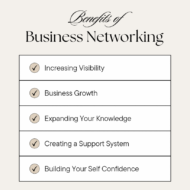Posted by Managementguru in Business Management, How To, Social Media, Startups
on Oct 28th, 2023 | 0 comments

Business networking events are an integral part of expanding your professional network and allowing your business to grow. However, many such events can feel forgettable and unproductive. To stand out and make a lasting impression, it’s crucial to go the extra mile in creating memorable experiences. This article will explore effective strategies to make your business networking event unforgettable. Define Your Purpose Before diving into event planning, define the purpose and objectives of your networking event. Are you aiming to introduce new products, foster collaboration, or simply build relationships? Knowing your goals will guide every decision you make in the planning process. Choose the Right Venue The venue helps to set the tone for your event. Opt for a location that aligns with your objectives and will appeal to your target audience. A unique or historical venue can leave a lasting impression and provide excellent conversation starters. Create A Theme A well-thought-out theme can add a layer of interest to your event. Consider a theme that resonates with your industry or business. For example, if you’re in the tech industry, a futuristic theme could be a great fit. Thematic decorations, food, and activities can make your event more memorable. Engaging Activities A memorable networking event incorporates interactive and engaging activities. Icebreakers, workshops, or panel discussions can help attendees to connect and learn. Additionally, consider incorporating technology such as event apps to facilitate networking and interaction. Food and Beverages Delicious food and beverages can be a significant draw for attendees. Consider offering a diverse range of options, including dietary accommodations. A well-catered event that includes delicious dessert catering can be memorable for all the right reasons. Unique Giveaways Branded giveaways can be a powerful tool for making your event unforgettable. Choose items that are not only useful but also align with your brand and theme. Personalized, high-quality items like custom notebooks, tech gadgets, or eco-friendly products can leave a lasting impression. Stellar Speakers Invite influential speakers who can provide valuable insights to your attendees. High-quality presentations can be a major draw for participants and make your event memorable. Networking Opportunities The main aim of a networking event is to connect people. Encourage networking by providing ample opportunities for one-on-one and group interactions. Mixers, speed networking sessions, and designated networking areas can be instrumental in making meaningful connections. Entertainment Incorporating entertainment can set your event apart from the rest. Live music, interactive performances, or even a photo booth can add some fun and excitement to the proceedings. Entertainment can also break the ice and help attendees to relax. Follow Up To make sure that your event has a lasting impact, follow up with attendees after the event. Send thank-you emails, connect on social media, and ask for feedback. This shows that you value their participation and are interested in continuing the relationship. Post-Event Content Create content that captures the highlights of your event, such as videos, photos, and blog posts. Share these across your social media channels and website to keep the memory alive and promote future events. Sustainability In this environmentally conscious world, demonstrating a commitment to sustainability can leave a lasting impression. Consider eco-friendly event practices, such as recycling, minimal waste, and sustainable transportation...

Posted by Managementguru in Branding, How To, Marketing, Sales
on Sep 26th, 2023 | 0 comments

It can be exceptionally difficult for small businesses to gain a foothold in their chosen target markets in the early years of trading. Customers may prefer to make purchases from more established firms who they have dealt with previously or may not even be aware of your company’s existence. As such, it can be a significant success for any small company to successfully navigate through the first few years of operation and to begin to generate meaningful levels of revenue and profitability. However, it is important to recognize the power of brand image in fueling the ongoing success of a firm. Small businesses with a strong and positive brand image will often be favored by customers who may choose their goods and services over the offerings of competitors. In this article, some unique ways in which small businesses can improve their brand image will be explored. Fundraising for charities A key way to improve the brand image of any small business is by supporting charitable organizations. This helps to demonstrate to consumers that your company has positive goals for the wider society (and is not purely focused on its own profitability) and is aiming to help support local communities. Ideally the goals and mission of the chosen charity will resonate with the values of your target market, so it is important to have a clear understanding of your customers’ beliefs and perceptions. Once you have chosen the charity you will be supporting, it is important to set a goal for the amount of funds you plan to raise. Consider adding a fundraising thermometer to your company website, which will indicate the progress that is being made towards the target amount. This will help to publicize the ongoing fundraising that is taking place and will increase the goodwill from your customer base. This charitable activity can also help to drive sales of the company’s products. If you donate a small proportion of your sales revenues from each item to the charity, customers may be inspired to purchase your products more often, so they help to support the fundraising initiative. This type of sales-linked fundraising benefits both your business and the charity—and is a key way to create a positive brand image with your target market and the wider community. Adopting Sustainable Practices In 2023, there is a growing need for all businesses to adopt sustainable practices. Evidence suggests that modern consumers will prefer to trade with organizations that can demonstrate they are lowering their carbon footprint, reducing waste, or using sustainable or recycled materials in their products, to name a few examples. In fact, research indicates that 87% of consumers have a more positive image of a company that can demonstrate sustainable business practices. In addition, the millennial generation is particularly concerned with sustainability and will actively choose brands that take steps to protect the environment and limit any adverse impacts on the planet from their business processes. As millennials will soon account for that majority of consumers, it is vitally important to be able to demonstrate sustainable practices to appeal to this important demographic and cultivate a positive brand...

Posted by Managementguru in Construction, Financial Management, How To, Real Estate Investment
on Sep 21st, 2023 | 0 comments

With their unique financial situations, entrepreneurs may encounter differences and challenges when obtaining a mortgage compared to traditional salaried individuals. However, with the right approach and preparation, entrepreneurs can secure a mortgage to purchase their dream home. With that in mind, here are some key steps and considerations for entrepreneurs looking to get mortgages. Documentation of Income One of the main challenges entrepreneurs face is demonstrating a consistent income to lenders. Unlike salaried individuals, entrepreneurs often have varying income sources, which can make it more difficult to prove their ability to repay a mortgage. It’s essential to provide thorough documentation of your income, including tax returns, profit and loss statements, and bank statements. Lenders typically assess your income over the past two years to determine your financial stability. Maintain Good Credit Your credit score is important in mortgage approval and the interest rate you’ll receive. Keep a close eye on your credit report, address any discrepancies, and work on improving your credit score if needed. A higher credit score should improve your chances of getting approved and securing more favorable terms. Debt-to-Income Ratio Lenders evaluate your debt-to-income (DTI) ratio, which compares any monthly debt payments to your monthly income. Keeping your DTI ratio low demonstrates your ability to manage your financial obligations. Pay off high-interest debts and avoid taking on new debt in the months leading up to your mortgage application. Organize Financial Records Having organized and up-to-date financial records is crucial. Lenders will want to see clear records of your business income, expenses, and taxes. Being able to present this information in a well-organized manner can help lenders understand your financial situation better. Seek Professional Advice Consider working with an experienced mortgage broker specializing in working with self-employed individuals. They can provide personalized guidance and connect you with lenders who are more flexible with their lending criteria. Then, choose mortgage lenders experienced in working with self-employed individuals and entrepreneurs. They will understand the unique financial complexities you face and can offer guidance on the best mortgage options for your situation. Show Consistency Demonstrate consistent income and business stability. Lenders often prefer entrepreneurs who have been running their businesses for a few years and have a steady income history. Consistency can instill confidence in lenders about your ability to continue making mortgage payments. Build a Healthy Savings A healthy savings account demonstrates your financial stability and ability to cover unexpected expenses. It can also serve as a great safety net in case your business experiences fluctuations in income. Consider a Larger Down Payment If you can gather together a larger down payment, it can improve your loan-to-value (LTV) ratio, which is the loan amount compared to the property’s value. A lower LTV ratio can lower your risk profile in the eyes of lenders and potentially lead to better terms. Get Pre-approved Before house hunting, get pre-approved for a mortgage. This shows sellers that you are a serious buyer and have taken the necessary steps to secure financing. Pre-approval also gives you a clear understanding of your budget, saving you time by focusing on homes within your price range. Provide a Detailed Business Plan & Be Transparent For entrepreneurs, presenting a detailed business plan can showcase your future earning potential and demonstrate your commitment to your business’s growth and success. Honesty and transparency are vital throughout the mortgage application process, but particularly when it comes to your business plan. Disclose all financial information accurately and answer any inquiries from lenders truthfully. In conclusion, entrepreneurs can secure mortgages by effectively showcasing their financial stability, income consistency, and responsible financial management. By understanding the unique challenges and requirements that come with self-employment,...

Posted by Managementguru in E Commerce, Emails and Spam, How To, Marketing, Sales, Social Media
on Sep 21st, 2023 | 0 comments

Building an email list is crucial for business growth. Here are 21+ effective ways to help you grow your email list by 522% in a year: 📩 Create High-Quality Content: Produce valuable and relevant content that attracts your target audience. 📩 Use Lead Magnets: Offer free resources like eBooks, templates, or guides in exchange for email sign-ups. 📩 Optimize Your Website: Ensure your website has clear and enticing calls-to-action (CTAs) for subscribing. 📩 Implement Exit-Intent Popups: Capture leaving visitors by showing popups with subscription offers. 📩 Run Contests and Giveaways: Encourage participation with email entry requirements. 📩 Use Social Media: Promote your email sign-up across social platforms to reach a wider audience. 📩 Guest Blogging: Write guest posts for blogs in your niche and include links to your signup page. 📩 Host Webinars: Collect email addresses from webinar registrations. 📩 Employ Content Upgrades: Offer additional content related to your blog posts in exchange for email subscriptions. 📩 Create Landing Pages: Develop dedicated landing pages with strong offers and CTAs. 📩 Conduct A/B Testing: Continuously test and optimize your subscription forms. 📩 Collaborate with Influencers: Partner with influencers to promote your sign-up offers. 📩 Use Referral Programs: Encourage current subscribers to refer friends and family. 📩 Offer Discounts: Give exclusive discounts to email subscribers. 📩 Network at Events: Collect email addresses at industry conferences or networking events. 📩 Use Paid Advertising: Invest in targeted ads to drive sign-ups. 📩 Segment Your List: Send personalized content to different subscriber segments. 📩 Run Surveys: Collect email addresses through surveys and offer incentives. 📩 Create Interactive Content: Quizzes and polls can be used to capture emails. 📩 Mobile Optimization: Ensure your sign-up forms are mobile-friendly. 📩 Implement Social Proof: Display the number of subscribers to boost credibility. 📩 Email Signature: Include a sign-up link in your email signature. 📩 Use Content Syndication: Share your content on platforms like Medium with a link to your sign-up page. Self Coaching Work Book Remember that building an email list takes time and consistency. Tailor your approach to your target audience and analyze your results to refine your strategies over time. Here are examples for each of the 23 strategies: Create High-Quality Content Write in-depth articles on topics like “10 Essential Wardrobe Pieces for Every Fashionista” to engage your audience. Use Lead Magnets Offer a free “Fashionista’s Style Guide” eBook in exchange for email sign-ups on your website. Optimize Your Website Place a prominent “Get Exclusive Fashion Updates” CTA button on your homepage. Implement Exit-Intent Popups When visitors try to leave your site, a popup could appear saying, “Wait! Subscribe for the Latest Fashion Trends Delivered to Your Inbox. Run Contests and Giveaways Host a “Fashion Makeover Contest” where participants must enter with their email addresses for a chance to win. Use Social Media Share stunning outfit photos on Instagram and include a link in your bio leading to your email sign-up page. Guest Blogging Write a guest post for a popular fashion blog and include a bio with a link to your website’s sign-up page. Use Social Media Host a “Mastering Color Coordination in Fashion” webinar and ask attendees to register with their email addresses. Employ Content Upgrades In a blog post about “Choosing the Perfect Wedding Attire,” offer a downloadable checklist of tips in exchange for an email subscription. Create Landing Pages Develop a dedicated landing page for your eBook offer, showcasing its benefits and a clear sign-up form. Conduct A/B Testing Experiment with different button colors and text for your subscription forms to determine the most effective version. Collaborate with Influencers Partner with a fashion influencer to feature your sign-up offer in their Instagram...

Posted by Managementguru in Productivity, SEO, Social Media
on Aug 29th, 2023 | 0 comments

In the ever-evolving world of social media, keeping up with the latest trends and strategies can be a daunting task. Whether you’re a seasoned social media marketer or just starting to build your online presence, having a comprehensive cheat sheet at your fingertips can make all the difference. In this guide, we’ve compiled 50 essential tips to help you navigate the complex landscape of social media. From understanding your audience to mastering platform-specific techniques, this cheat sheet is your go-to resource for boosting engagement, building your brand, and staying ahead of the curve. Here are 50 social media tips: Know Your Audience: Understand your target audience’s interests and preferences. Consistent Branding: Maintain a cohesive brand identity across all platforms. Content Calendar: Plan and schedule posts in advance. Use Hashtags: But don’t overdo it. Engage with Followers: Respond to comments and messages promptly. Quality over Quantity: Focus on creating valuable content. Visual Appeal: Use high-quality images and graphics. Video Content: Incorporate videos for higher engagement. Storytelling: Share compelling stories related to your brand. Leverage User-Generated Content: Repost content from your followers. Analytics: Regularly review insights and adjust your strategy. Timing Matters: Post when your audience is most active. Platform Specific Content: Tailor content to each platform’s audience. Live Streaming: Host live events and Q&A sessions. Influencer Collaborations: Partner with influencers in your niche. Community Building: Foster a sense of community among your followers. Educational Content: Share informative content. Behind-the-Scenes: Show the human side of your brand. Contests and Giveaways: Boost engagement with these activities. Ad Campaigns: Consider paid advertising for wider reach. Profile Optimization: Use keywords in your profile for discoverability. LinkedIn Networking: Connect with industry professionals. Twitter Chats: Participate in or host Twitter chats. Instagram Stories: Use interactive features like polls and questions. Pinterest Boards: Organize content into thematic boards. Facebook Groups: Create or join groups in your niche. Snapchat Geofilters: Use custom geofilters for events. TikTok Trends: Stay updated on TikTok trends and challenges. YouTube SEO: Optimize video titles and descriptions. Google My Business: Update your business listing regularly. Email List Building: Promote your social channels in emails. LinkedIn Articles: Publish long-form content on LinkedIn. Geo-Tagging: Add location tags to posts for local visibility. Pinterest Keywords: Use relevant keywords in descriptions. Twitter Lists: Organize accounts you follow into lists. Instagram Reels: Create short, attention-grabbing videos. LinkedIn Endorsements: Give and request endorsements. Facebook Insights: Dive deep into audience demographics. Pinterest Analytics: Track which pins are driving traffic. YouTube Playlists: Group related videos together. Tag Relevant Accounts: Increase visibility by tagging others. Pin to Top: Feature important posts on your profiles. Monitor Mentions: Keep tabs on when your brand is mentioned. Use Emojis: Emojis can add personality to your posts. Create Infographics: Share data in a visually appealing way. LinkedIn Recommendations: Request and give recommendations. Facebook Live: Stream live events and updates. Pinterest Rich Pins: Enable rich pins for product details. Tweet Polls: Engage followers with interactive polls. Stay Updated: Social media is ever-evolving; stay current with trends and algorithm changes. Loading…...










